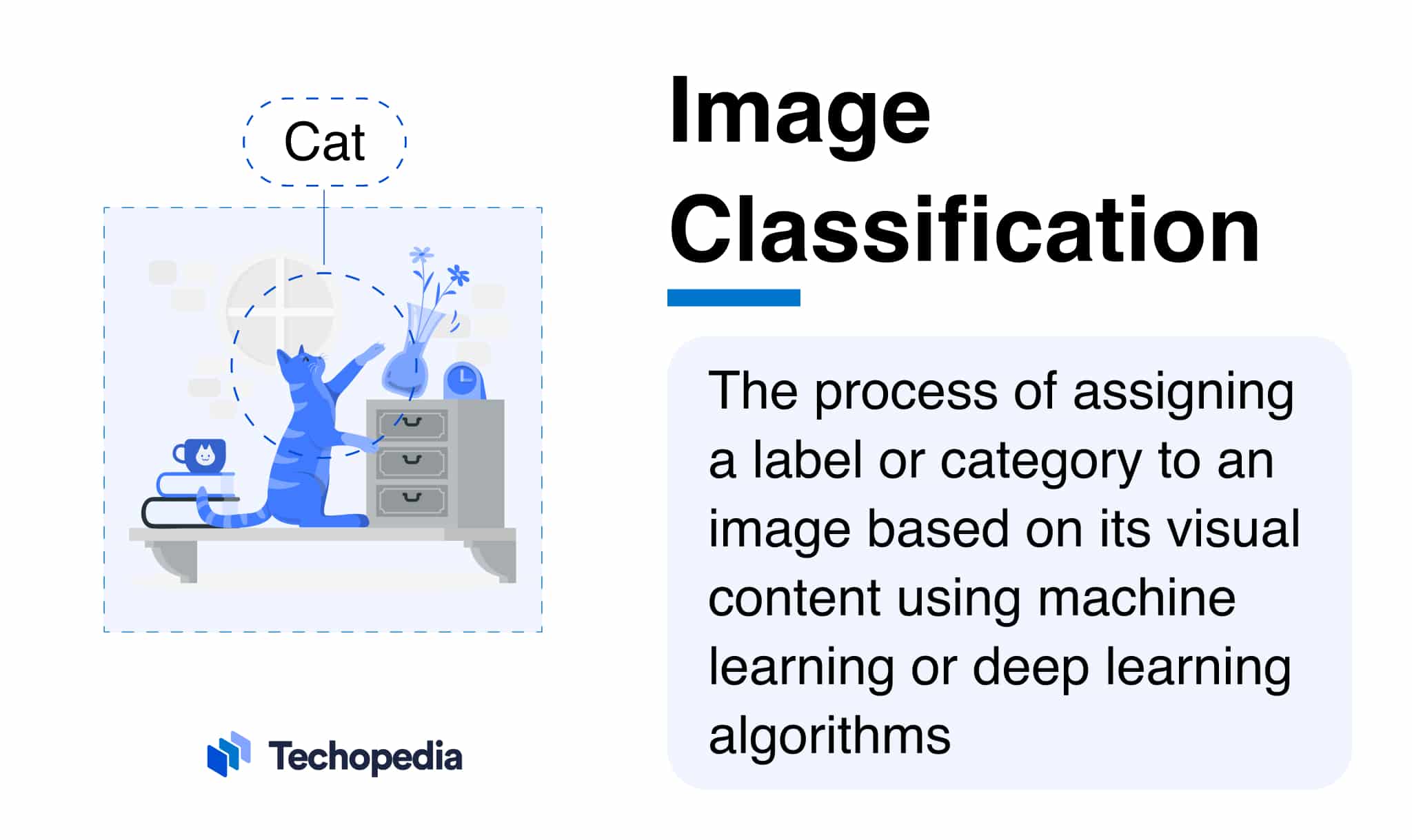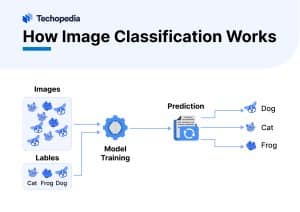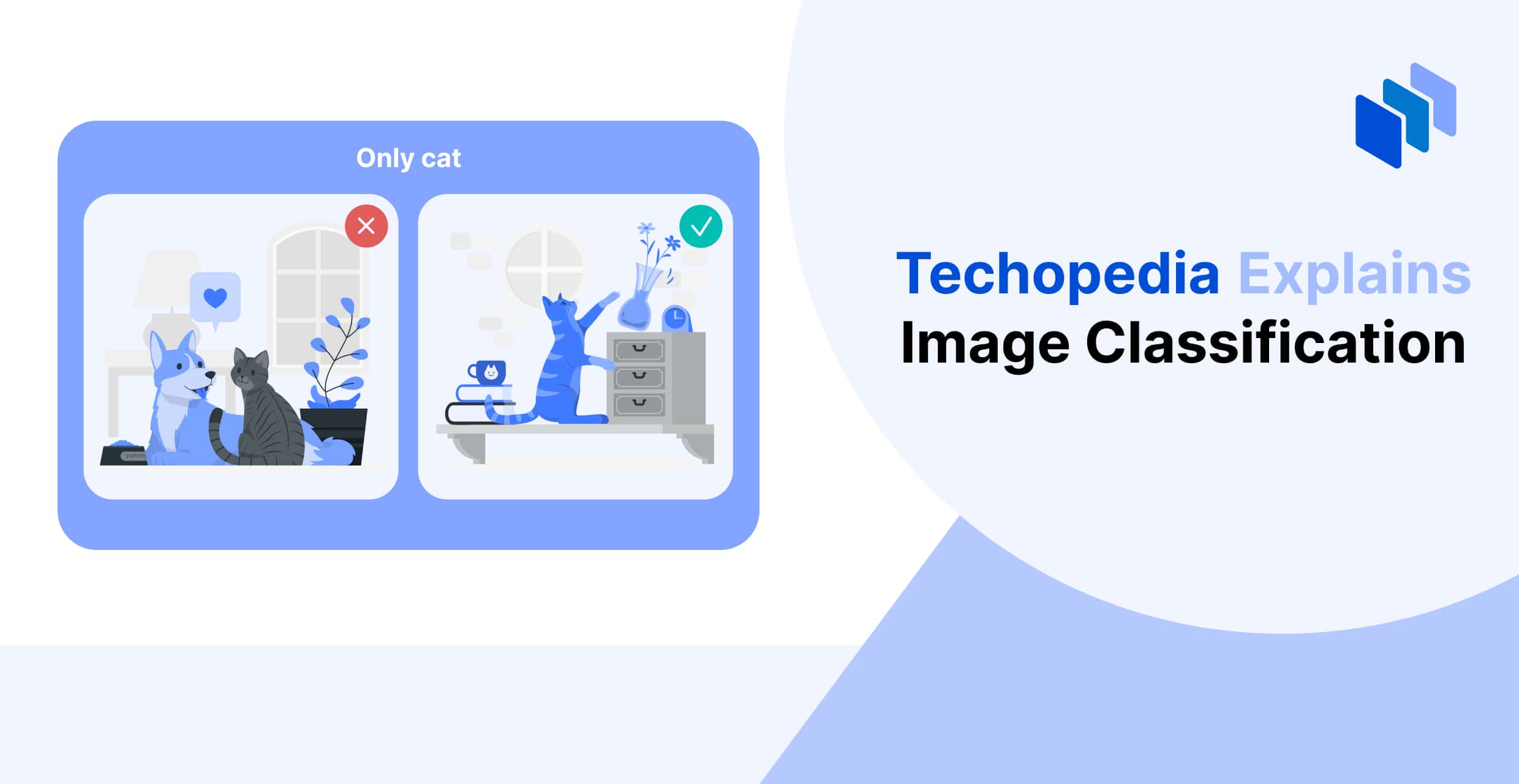What is Image Classification?
Image classification is a process that uses machine learning (ML) to analyze an image and determine its main subject. Image classification plays an important role in more advanced computer vision tasks such as object detection and object localization.

Key Takeaways
- Image classification is an important building block for more complex computer vision tasks that interpret visual information.
- Deep learning algorithms are used to predict classifications (class labels).
- The algorithms use feature extraction to predict the most appropriate class label.
- To become accurate, complex algorithms need to be trained with millions of images.
- In order to facilitate accurate data labeling, publicly available datasets are often used for model training.
How Image Classification Works
Image classification uses deep learning algorithms to extract relevant features from an image and predict, based on those features, what high-level category (class) the image belongs to.
Once trained, the model can then be presented with new, unlabeled images and predict their categories based on the patterns it has learned.
On the back end, the category may be accompanied by a confidence score that indicates how sure the model is of its classification. The accuracy of the predictions depends on the quality and quantity of the training data, as well as the complexity of the model itself.

Types of Image Classification
Image classifications can be binary, multiclass, or multilabel.
Image Classification Algorithms and Models
Image classification algorithms can be either hierarchical or flat.
Flat algorithms directly predict the final class of an image. Hierarchical algorithms first predict the most general class and then progressively narrow down the prediction to more specific subclasses at lower levels.
The choice between flat and hierarchical algorithms depends on the specific problem and the trade-off between speed and accuracy. Flat algorithms are generally preferred for simpler problems with a limited number of classes, while hierarchical algorithms can offer better performance and interpretability for complex problems with a large number of classes and a clear hierarchical structure.
How Image Classification Models are Trained
Image classification models can be trained with supervised, unsupervised, semi-supervised, or self-supervised (transfer) techniques.
Supervised Classification Models
Supervised classification requires new models to be trained with labeled images. The amount of labeled data needed depends on the complexity of the task and the diversity of the images the model is expected to classify.
Simple tasks with few classes might require hundreds of images per class, while complex tasks with a large number of classes might require millions of labeled images.
Unsupervised Classification Models
Unsupervised classification uses unlabeled images to train a model. The model analyzes the images to find patterns and uses the patterns to cluster similar images together in a class. This technique uses a human in the loop (HiTL) strategy to assign a label to each class.
Semi-Supervised Classification Models
Semi-supervised classification models use both labeled and unlabeled data. Essentially, the model uses the labeled data to guide the learning process for a larger unlabeled data set. This technique is useful when labeled images are scarce or expensive.
Self-Supervised Classification Models
Self-supervised models are trained on a foundation model and use transfer learning to predict classes for new, unseen images.
For example, zero-shot classification models are trained with textual descriptions of different classes they need to recognize. This technique allows the model to recognize classes they haven’t explicitly seen during training.
CNN Image Classification
Most image classification models today use convolutional neural network (CNN) algorithms. CNNs have a unique architecture that is specifically designed for processing and classifying images. This type of learning algorithm can also be adapted for related tasks like object detection.
Image Classification vs. Object Detection
Image classification and object detection are both important tasks in computer vision, but they each have different objectives.
Image classification predicts the image’s main subject. Object detection predicts what objects are in the image.
Techniques Used in Image Classification Assessment
Machine learning engineers can use a variety of assessment techniques to understand the strengths and weaknesses of their image classification models. This information is essential for improving the model’s performance, addressing biases, and ensuring the model’s effectiveness in real-world applications.
Important assessment techniques include metrics that state:
Image Classification Applications
Image classification has many applications in other computer vision tasks, including:
- Object detection
- Object counting
- Image segmentation
- Image retrieval
- Facial recognition
- Medical image analysis
- Action recognition
Image Classification Examples
Image classification has a wide range of uses across various industries and fields of study. For example, the technology can be used to categorize satellite or aerial images into distinct land cover classes such as forests.
Image classification in remote sensing is a powerful tool for monitoring deforestation and tracking changes in land use over time.
Image classification is also used to categorize images users publish on social media sites. For example, Facebook and Instagram use image classification to identify images that don’t meet their acceptable use standards. Object detection can further enhance this process by predicting specific elements that contribute to an image’s classification.
Image Classification Pros and Cons
Image classification models, like any type of artificial intelligence (AI), have both advantages and disadvantages.
- Automates the process of categorizing images
- Can handle large volumes of image data efficiently
- Supports a wide range of computer vision tasks
- Insufficient or biased training data can lead to inaccurate predictions
- Training complex image classification models from scratch requires significant computational resources and can be expensive
- Image classification models are vulnerable to adversarial attacks
The Bottom Line
The evolving nature of artificial intelligence (AI) makes it necessary to continually reevaluate image classification’s meaning to include new techniques and technologies. For example, in the future, image classification models are likely to be integrated with object detection models, and object detection models will be integrated with object counting and object localization models.
FAQs
What is image classification in simple terms?
What is zero-shot image classification?
What is image classification in machine learning?
How do you use image classification?
Why do we need image classification?
References
- Adversarial images and attacks with Keras and TensorFlow – PyImageSearch (Pyimagesearch)
- Object Counting | Papers With Code (Paperswithcode)
- Object Localization and Image Localization – viso.ai (Viso)






